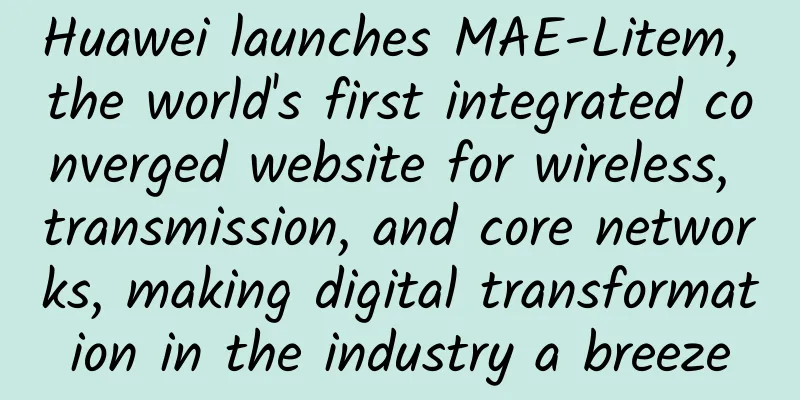Three essential conditions for achieving network convergence in 2018 and beyond

|
Network convergence is defined as the use of multiple communication modes on a single network to achieve convenience and flexibility that would not be available on their own separate infrastructures. Looking ahead to 2018 and beyond, a stable converged network will demonstrate good flexibility, reliability and help save costs. Although 5G is still several years away, the industry still has a lot of preparation work to do to ensure that the network is ready for change. In the era dominated by the Internet, the ubiquitous demand for bandwidth is driving fixed and wireless networks toward network convergence. In the future, all networks will turn to high-bandwidth or "broadband" networks to transmit high-speed data from data sources or processing sources to wireless network distribution points and vice versa to upper layers.
Current and Future The evolution of the next generation of wireless network architecture is the densification of 4G/LTE and 5G wireless networks, a trend that well reflects the integration of physical assets of fixed and wireless access points. For example, in North America, wireless networks have relatively wide coverage, and wireless coverage is essential for all applications. As consumers' demand for data continues to increase, capacity issues have emerged. Wireless network capacity is expected to increase in the following ways: 1) Adopting more advanced modulation techniques, or increasing spectrum and spatial addressing; 2) 4G/LTE densification and potential 5G mobility can create more capacity from a spatial perspective; 3) The spacing between small cell base stations is becoming smaller and smaller (250 meters), and the bandwidth per square meter increases due to fewer users per access point; 4) Fixed wireless 5G in the Sub-6 GHz band and millimeter wave band (i.e. 28GHz) is expected to bring more bandwidth and additional spectrum to the network. When it comes to convergence, we generally consider the following three types of networks and their typical configurations:
The deployment of the above three networks is different due to the need to meet different communication applications. Today, the networks are emulating each other and tending to be unified, and since the equipment requirements are the same, the operator's operating expenses and capital expenditures will be reduced. Network convergence not only promotes the unification of networks, but also greatly reduces capital expenditures due to the standardization of manufacturing processes and NFV/SDN (network function virtualization/software defined network). Network Convergence Requirements for network convergence There are three necessary conditions to achieve a converged network: 1. Power supply (for wireless access points and other edge devices) Every wireless access point requires power. However, until the network is planned, it is often assumed that power is always available, or even ignored. Every traditional communications network has different power considerations, but there is no doubt that the power requirements of converged networks are real and important. Traditional telephone networks that still use twisted pair wiring can provide low-power power to small cell base stations. For general converged networks, if there are no wireless access points in the distribution cabinet, traditional telephone networks require utility power to support its operation. FTTH PON networks cannot be powered without the installation of service lines and electricity meters. Although the installation cost and installation time of service lines are within a reasonable range, installing service lines at hundreds or even thousands of access points often becomes a bottleneck of the project and brings a heavy economic burden. It is estimated that 80% of HFC lines can be powered due to power support over coax. Coax is often used as a feeder cable in parallel with the fiber node, and can even provide power on the fiber section of the line. So, in most cases there is more than enough power available for a Wi-Fi hotspot or small cell base station. 2. Backhaul (data transmission from edge access points to central data storage or data processing centers) Traditionally, cellular base station backhaul is accomplished by high-speed twisted pair, microwave, or fiber optic links from the radio location to a central equipment location. These can be either dedicated links or shared via time domain or wavelength division multiplexing. In existing HFC networks, backhaul capabilities can also be achieved through DOCSIS. DOCSIS provides connectivity through coaxial cable or fiber links. In addition, wireless access points activated through PoE (Power over Ethernet) can also regulate power from the HFC line and provide DOCSIS channels. For small cell base stations, the approach depends on the technology deployed. Although tight time and latency requirements are challenges, standard setting organizations are currently working to address these issues. The “forward haul” wireless network data uses CPRI (Common Radio Protocol Interface) signaling. Currently, LTE radios use this signaling technology if multi-point cooperation is deployed to achieve spectrum reuse and mitigate interference. The dedicated link is usually a pair of fibers per deployed radio, but the fiber can be shared by multiple forward hauls through wavelength division multiplexing, provided that the signaling paths are independent and do not exceed 15 kilometers. In addition, new technologies such as the packet-switched ECPI standard are also changing. This new standard is designed to reduce the sensitivity of 5G latency requirements and the required data rates while still allowing centralized radio coordination to reuse spectrum. 3. Site Acquisition In the future, most wireless network mobility deployments for LTE densification or 5G will be in high-capacity urban and suburban areas. Site acquisition is always a major component of any wireless network and requires time and financial security. 4G/LTE wireless network densification aims to increase capacity rather than coverage. Setting up at about 6 to 9 meters in the air can produce small cell base station coverage and achieve the required additional capacity. Small cabinet cell base stations can be used underground, and different signal tower heights and concealment methods can be selected. This small cell base station can be very hidden and arranged along the existing paths built for brackets and cabinets. The convergence of wireless and wired networks is a natural economic and technological evolution driven by the densification of wireless small cells. Power, backhaul and site acquisition are the most important factors in the design of any radio access network. In 2018 and beyond, the trend towards network convergence will continue. Physical network assets will be gradually merged, and wireless network backhaul/fronthaul, FTTx, HFC, fixed wireless network access, and commercial high-speed data requirements will share line facilities through high-utilization fiber equipment. In addition, NFV will continue to evolve, allowing all central processing facilities (whether data centers, headends, operator center rooms, or mobile switching centers) to run applications on commercial products (COTS) and eventually achieve physical mergers. In addition, the signaling technology outside the central computer room will shift to an IP packet switching network, allowing the signaling of different services to be integrated into the same data stream. Vendors have reached a consensus and are working together to promote the financial incentives for network convergence and the need for cost-effective solutions. New solutions are being developed to promote convergence, and more will emerge in the coming years. |
<<: Huawei Cloud Ecosystem is "Very Different" in 2018, Focusing on "Quantity" and "Quality"
>>: Should I turn off my router when I go to bed at night? This is a question
Recommend
RabbitMQ communication model routing model
Hello everyone, I am amazing. Today, I will lead ...
Six great ways to improve your web page loading time
【51CTO.com Quick Translation】 Aberdeen Group once...
7 IT reorganization mistakes to avoid
The way IT operates is changing constantly and ra...
What is the relationship between API, ESB, ServiceMesh, and microservices?
Introduction I mentioned before that I would like...
80VPS new platform Los Angeles Cera data center (China Unicom CUVIP line) KVM simple test
Some time ago, I shared the news of 80VPS's n...
The battle between local deployment and cloud-managed WLAN architecture
Enterprises that need to upgrade their traditiona...
Wi-Fi 6 is here, are you interested?
If we were to vote for the "hottest names&qu...
The role of LoRaWAN and IoT in optimizing asset management
The role of the Internet of Things (IoT) and LoRa...
Top SD-WAN vendors and manufacturers in 2021
Software-defined WAN (SD-WAN), as the name implie...
The property management company asked for 300,000 yuan as an “entry fee” for 5G to enter the residential area. The real problem is the problems beyond technology.
The 5G waves are rising higher and higher. In ear...
CUBECLOUD: Los Angeles/Hong Kong Lite series 30% off from 27 yuan/month, Pro series 15% off from 58 yuan/month
CUBECLOUD is a Chinese hosting company establishe...
Various technical measures to eliminate data center hot spots
According to a study by the Uptime Institute, up ...
HostingViet: Vietnam VPS monthly payment 30% off, 28 yuan/month-1GB/20G SSD/unlimited traffic
HostingViet has updated the validity period of th...
Do I need to turn off data traffic after connecting my phone to WiFi? The operator gave the "answer"
Nowadays, everyone has a smartphone. As long as i...
Huawei's Wu Hui: Join hands with partners to be the "bridge builders" and "road builders" of the intelligent era
Every generation has its own mission of transform...









